General election 2019: preview of the East of England
In the run-up to the 2019 general election, the Democratic Audit team is previewing the key contests and political divides in each of the country’s regions. Here we discuss the East of England, focusing on the crucial seats for each party based on 2017’s marginal results, the latest polling, and how smaller parties and the Leave-Remain dynamic change the established electoral contests.
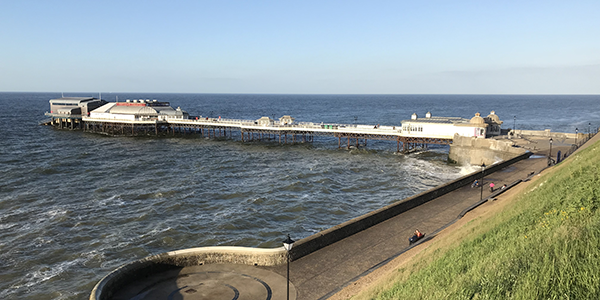
Cromer. North Norfolk. Picture Richard Humphrey, geograph.org/(CC BY-SA 2.0) licence
The East of England region skirts the north and east edge of London, encompassing commuter belt towns, and stretches as far as the North Norfolk coast, covering six counties: Hertfordshire, Bedfordshire, Essex, Cambridgeshire, Norfolk and Suffolk. Numbers wise it is dominated by some very safe Conservative seats in solidly Leave territories, particularly across rural Norfolk and Suffolk, and all of Essex. Overall in 2017, the Conservatives took 50 of the 58 seats here, Labour seven, and the Lib Dems one.
Four seats changed hands at the last election. Labour gained Bedford, Ipswich and Peterborough from the Conservatives (and held on to Peterborough in the by-election earlier this year). The Conservatives gained Clacton from UKIP, which is the only seat to have returned a UKIP MP at a general election, when Douglas Carswell held it in 2015, having also won it at a by-election the previous year (which he called on his defection from the Conservatives to UKIP). UKIP’s demise and the lack of Brexit Party candidates in Conservative-held seats further benefits the Tories here.
For Labour, of its seven seats Luton North and South, Norwich South and Cambridge are safe (though the latter is one of the most Remain constituencies in the country and can expect to see second-placed Lib Dems gaining ground). In other Remain-leaning seats in Cambridgeshire and Hertfordshire the Lib Dems are campaigning hard, and are on course to pick up one or two seats, though the overall picture of Conservative dominance will not change.
Map of the East of England 2017 general election results, with key seats labelled
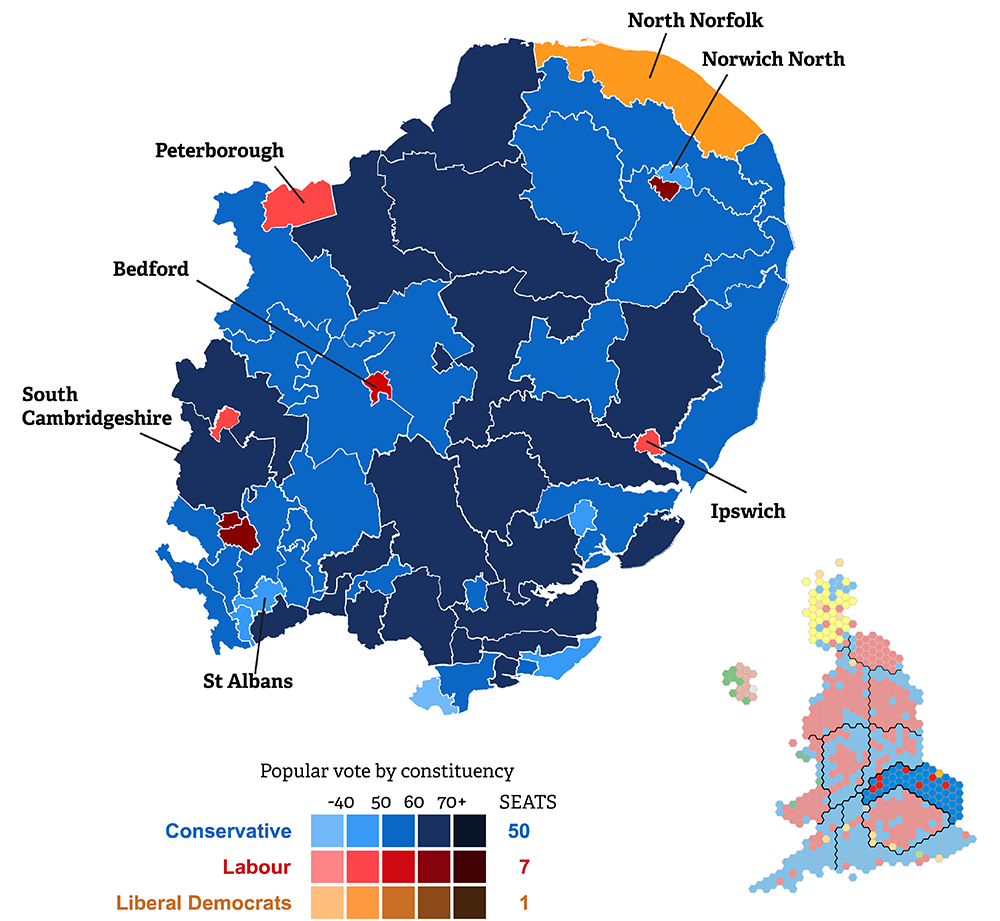
Source: Adapted from map by DrRandomFactor & Ch1902 /Wikipedia. Key constituency contests for 2019 labelled.
For all seats in the region, you can find full details of the candidates standing in 2019 and their social media links at DemocraticDashboard.com. It also gives complete results from the 2017 general election, estimated 2016 EU referendum results and details about the constituency so you can best make up your own mind how to vote.
The estimated constituency results for all seats in the East of England in 2019, and regional vote shares given in figures 1 and 2, come from YouGov’s large MRP poll published on 10 December, which provides the best data available at the time of writing. A sample of 105,612 people was polled across the UK, and used, along with demographic and other data, to create estimates for each constituency.
Figure 1: Number of seats won by each party at the last three general elections in the East of England, and 2019 estimates from YouGov polling, 10 December
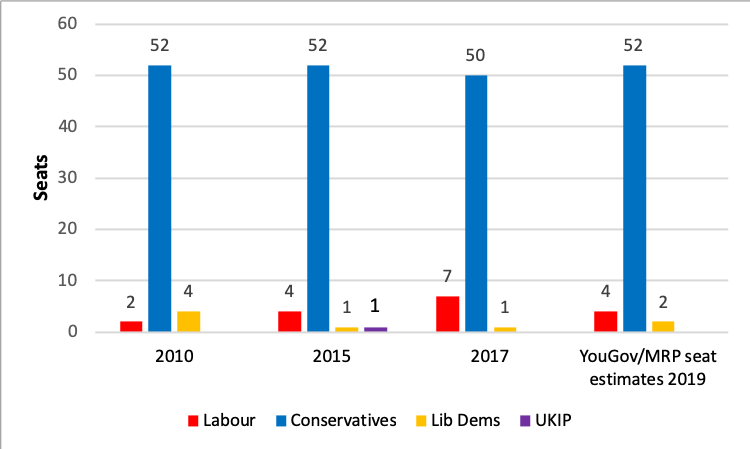
Note: 2019 figures from YouGov MRP seat estimates, 10 December, 2019.
Figure 2: Parties’ shares of the votes in the East of England at the last three general elections, and estimated vote shares from YouGov’s 10 December poll
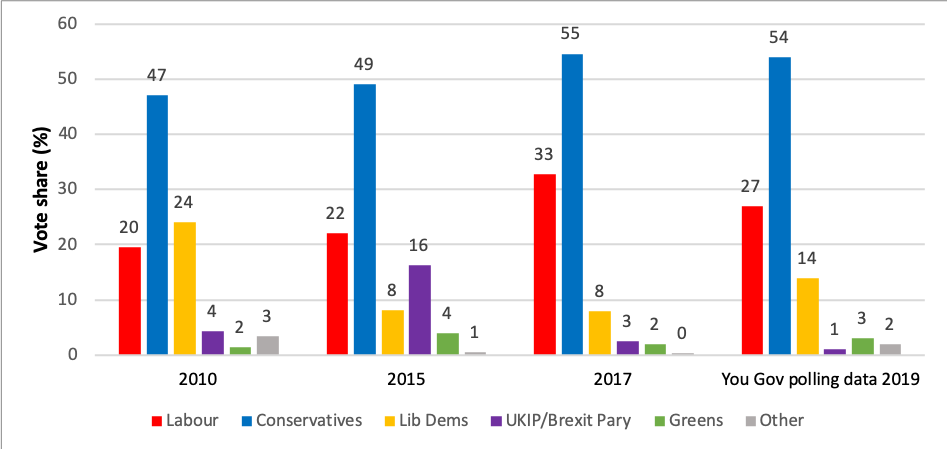
Note: 2019 polling source from Benjamin Lauderdale and Jack Blumenau for YouGov, 10 December, national MRP poll.
Seats the Conservatives are targeting
Three seats the Conservatives lost in 2017, and which have been marginal in recent general elections, Peterborough, Bedford and Ipswich, are all estimated to return to the Conservatives this time around. The Conservatives lost Peterborough by just 607 votes to Labour in 2017. Earlier this year the new Labour MP Fiona Onasanya faced a recall petition, following her conviction for lying about a speeding offence. The subsequent June by-election was held at the Conservatives’ polling nadir, and they fell further back to third place, while the Brexit Party were at their peak and polled second, though they failed to unseat Labour. At this general election, the same parties are in contention, but with fortunes reversed. The Conservatives are currently predicted to retake the seat, with the Tories’ forecast to achieve 48% to Labour’s 40% on YouGov’s estimate. The two main parties look likely to be able to squeeze the Brexit Party and Lib Dems (est. 4% each) here.
In North Norfolk, former Lib Dem MP Norman Lamb, who is standing down this election, won the seat from the Conservatives in 2001, and it has been a target for them to win back ever since. Lamb built a sizeable enough majority over successive elections to withstand the Lib Dem collapse in 2015 and he was one of the eight Lib Dem MPs that remained in Parliament that year. With him standing down, this Leave-leaning seat is forecast to be won by the Conservative candidate Duncan Baker.
Labour strengths and targets
The city of Norwich is split between two seats with quite different contests for Labour. Norwich South is home to the University of East Anglia and it has gone from a multi-party marginal, which the Lib Dems took in 2010, to an increasingly safe Labour constituency since Clive Lewis gained the seat in 2015. His vote increased a massive 22% to 61% in 2017 to make it their second safest seat in the region after Cambridge. In Norwich North Labour are targeting this hyper-marginal Conservative seat, which Chloe Smith won from Labour in a 2009 by-election and where she now defends a 1% majority. On current polling, though, it is beyond Labour’s reach, and they are 3% behind on YouGov’s forecast.
Another Conservative marginal, where Labour was just behind in 2017, is Watford. However, the Conservatives are currently forecast to hold this seat, and the Lib Dems, who run the council and have a directly elected mayor here, are also targeting it, though according to YouGov they are a distant third place.
Liberal Democrat targets
Offsetting their forecast loss of North Norfolk, the Lib Dems look well positioned to gain one or two seats in the Remain-voting parts of the East of England. The more probable is the commuter town of St Albans, which is now clearly forecast for the Liberal Democrats. The contest is very close in South Cambridgeshire where former Conservative MP turned Liberal Democrat Heidi Allen had a huge 25% majority when elected as a Conservative, but is standing down. Lib Dem candidate Ian Sollom is helped by a ‘Unite to Remain’ pact, so no Green candidate is standing here. In the last week of the campaign YouGov’s forecast for this seat has changed, with the Lib Dems now just ahead on 45% to the Conservatives’ 41%, while the Labour vote is squeezed to 14%.
At the start of the campaign, the party might have expected to gain more seats like these from the Conservatives, wherever the Remain vote was strong, but on current polling, while they will substantially improve their vote share and move to second place in several seats, they are not currently forecast to win any more in the East of England. For example, in Hitchin and Harpenden they would have to overturn a Conservative majority of 12,000. The seat voted to Remain at a level of 60%, but the scale of the majority and a split opposition should insulate the Conservatives. Current forecasts put the Conservatives on 46%, Lib Dems on 31%, and Labour dropping to third on 20%.
An Independent challenge
On the edge of this region, the London commuter belt constituency of South West Hertfordshire is another seat where, as in Beaconsfield (in the South East region), an independent former Conservative MP is standing. David Gauke was first elected as a Conservative in this safe seat in 2005. He had a 32% majority in 2017 – and it is evenly split in terms of the Brexit vote – so overturning the Tories here must be considered an improbable task, given how hard it is for independent candidates to win. However, his social media-savvy campaign has grabbed attention, and he has been endorsed by former Prime Minister John Major and others. He is currently forecast by YouGov to come second and is the recommended candidate for tactical Remain voting sites, though the Lib Dems also have a candidate standing here.
Brexit Party retreat
By standing down in all Conservative-held seats, the Brexit Party gave up their chances of gaining support where UKIP had previously done extremely well in the East of England, and where Farage and allies had targeted in the past. Fruitful seats for them might have included Clacton, which Conservative defector Douglas Carswell won under the UKIP banner in a by-election and in the 2015 general election, and Thurrock, where they maintained a strong third-placed showing of 20% in 2017. This three-party split made Thurrock the Conservatives’ most marginal seat in the region (see Figure 3), but without the Brexit Party standing here it becomes much more secure for the Conservatives.
Figure 3: The East of England’s most marginal seats (by % vote) from the 2017 election
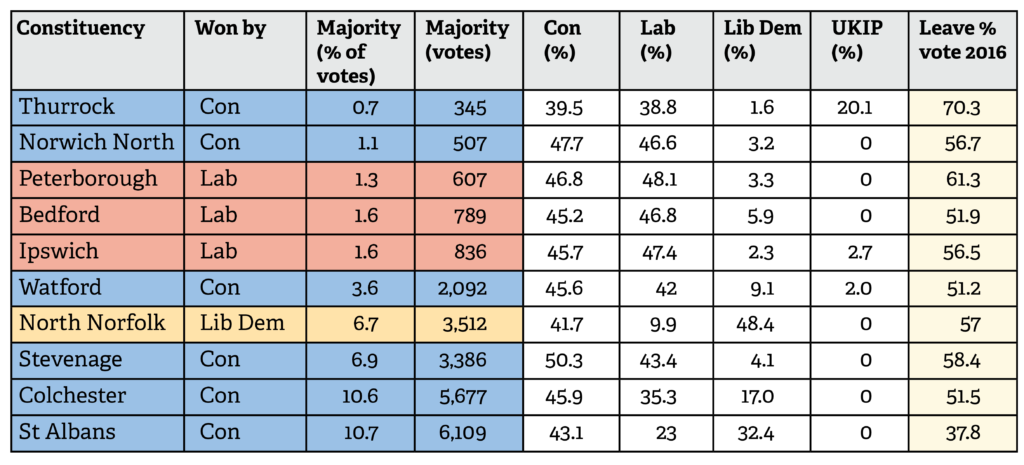
Note: The Leave % for each the 2016 Brexit referendum by constituency (and mentioned throughout this article), are Chris Hanretty’s estimates. You can also find these for each constituency (including those we don’t discuss), along with general election results at DemocraticDashboard.com.





 Democratic Audit's core funding is provided by the Joseph Rowntree Charitable Trust. Additional funding is provided by the London School of Economics.
Democratic Audit's core funding is provided by the Joseph Rowntree Charitable Trust. Additional funding is provided by the London School of Economics.